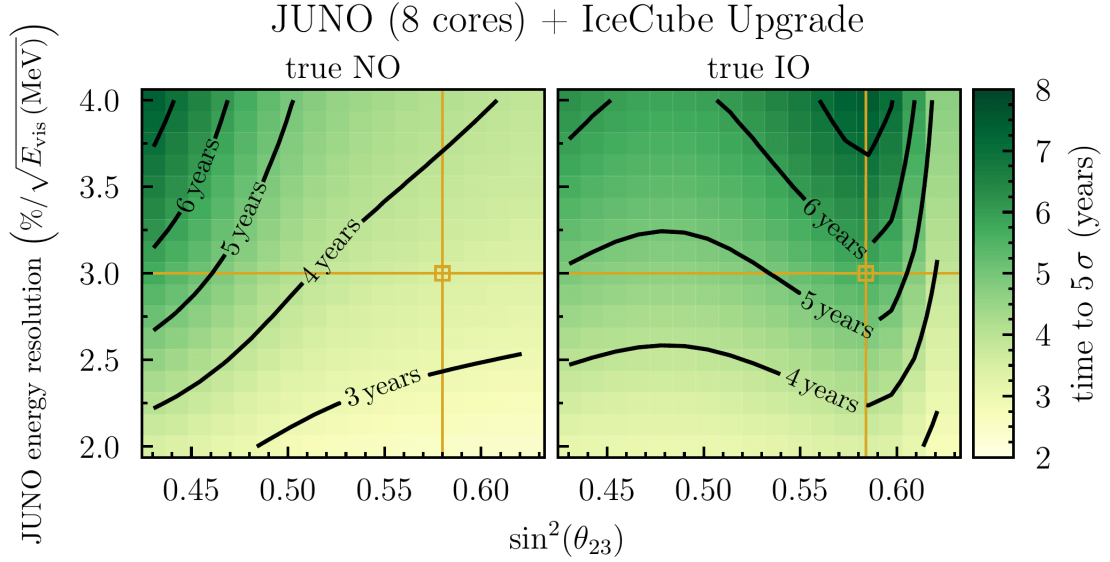If you are asked to find the weight of an everyday object like a book or coffee mug, you can simply weigh it on a scale. But when the object is very, very light—like a particle—measuring mass gets very tricky. And when you get to particles as light as neutrinos, the difficulty in measuring their mass is a huge problem. Solving it could alter the way we understand nature.
Neutrinos are chargeless, fundamental particles that are abundant in the universe. They interact in three varieties, known as flavors. Perhaps confusingly, they travel as states of three different masses that don’t exactly correlate with these flavors, called neutrinos 1, 2, and 3. As a result, neutrinos can change, or oscillate, from one flavor to another depending on their energy and distance from their source.
But physicists don’t know which mass state is the heaviest. Either neutrino 3 is heavier than neutrinos 1 and 2, known as the “normal ordering” of neutrino masses, or neutrino 3 is lighter than the other two, known as “inverted ordering.” Which is correct represents the current question of neutrino mass ordering, one of the biggest outstanding problems in neutrino physics today.
With two new neutrino experiments on the horizon—the IceCube Upgrade and the Jiangmen Underground Neutrino Observatory (JUNO)—physicists will soon have access to more sensitive measurements of neutrino oscillations. In anticipation of this, the IceCube Collaboration and the JUNO Collaboration have studied the combined performance of their respective experiments, which employ very distinct and complementary routes in order to resolve the neutrino mass ordering. In a paper submitted recently to Physical Review D, they show that a combined analysis could eliminate the wrong mass ordering in as few as three years from the start of data taking.

The IceCube Upgrade is an extension of the IceCube Neutrino Observatory, an array of over 5,000 optical modules buried in a cubic kilometer of ice at the South Pole. The Upgrade, scheduled to deploy during the 2022-2023 polar season, will insert more than 700 new optical modules into DeepCore, the center of the IceCube array, enabling higher sensitivity to neutrinos with low energies produced in the atmosphere.
Meanwhile, JUNO is a 20-kiloton liquid scintillator detector currently under construction near Jiangmen in southern China. Though the nominal assumption is that JUNO will measure neutrinos from 10 nuclear reactor cores, there may only be eight running when they anticipate starting to take data in 2021. This was taken into consideration for this analysis.
The study was conducted by researchers at Johannes Gutenberg-Universität Mainz in Germany, including PhD students Jan Weldert and Thomas Ehrhardt. “We wanted to find out whether the power of the phenomenological mass ordering sensitivity study by Blennow and Schwetz carried over to a realistic modeling of JUNO and IceCube and investigate which role the imminent IceCube Upgrade will play in the analysis,” says Weldert.
To combine JUNO and the IceCube Upgrade, the researchers first assumed that each experiment had run for a certain amount of time, then simulated the predicted experimental outcomes. These outcomes vary depending on whether the neutrino masses follow normal ordering or inverted ordering. Next, they performed a statistical test that told them how much more likely it would be for both outcomes to occur simultaneously as the result of normal or inverted ordering. Since JUNO and IceCube are highly sensitive to very different manifestations of neutrino oscillation, their test had strong discrimination power.
They found that combining results from JUNO and the IceCube Upgrade could definitively rule out the wrong mass ordering—as in, the mass ordering that is not true in nature—on a timescale of three to seven years.
“The holy grail for the neutrino mass ordering would be to reject the wrong hypothesis with a 5σ result. Neither the Upgrade nor JUNO can reach that by themselves—nor can any of the other experiments currently out there,” says Sebastian Böser, a professor of physics at Universität Mainz who helped lead the study. “But if we combine JUNO and the IceCube Upgrade, 5σ might be there already in 2026, with three years of data from each.”
Even if JUNO was only operating on eight reactor cores instead of 10, the researchers found they could reject the wrong mass ordering with the coveted 5σ after about 3.5 or 5.5 years, assuming normal ordering or inverted ordering, respectively.
The researchers also studied a combined analysis with JUNO and PINGU, a proposed low-energy extension of IceCube that takes the concept of the Upgrade even further. They showed that this combination would only need half the time to determine the mass ordering.
“Our results underline the importance of pursuing complementary experimental approaches toward solving the remaining riddles posed by neutrinos,” says Ehrhardt. “Their mass ordering is particularly elusive and has certainly been keeping us on our toes.”
The obvious next step is to turn this into a real analysis, not just a simulation study. But first things first: both JUNO and the Upgrade must be built and take some data. Then, the two collaborations can work together so that the exciting potential of this combined measurement can be realized.
But if it can all come together, there may be exciting results in the future. “IceCube can play an important role for the neutrino mass ordering discovery,” says Weldert.
info “Combined sensitivity to the neutrino mass ordering with JUNO, the IceCube Upgrade, and PINGU,” IceCube Collaboration: M. G. Aartsen et al., Physical Review D 101 (2020) 3, 032006, journals.aps.org, arxiv.org/abs/1911.06745